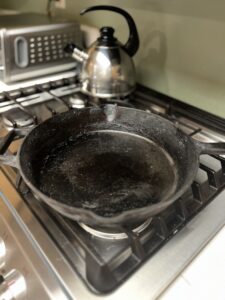Most people are not iron deficient in the way you would think. I’ve been testing all of my clients on my Qest4 “cellular health” scan and finding some alarming levels of iron trapped in tissue. The problem is that the result coming from a blood draw does not reflect what kind of iron it is or what is available or “trapped” in the tissue. Many of us have inorganic iron stuck in the tissue that needs to be safely pulled out and can be the primary cause of many of our complaints. We also need to be consuming heme iron, maybe small amounts of properly prepared non-heme iron (assuming the gut has the proper strains to digest it), and a complete avoidance, if possible, of inorganic iron.

One way to do this is to ditch your cast iron skillet and start consuming properly raised meats, including organ meats. The cast iron skillet is the biggest offender when it comes to a person consuming the wrong kind of inorganic iron. Below are some details regarding nutrients found in readily available foods that can be added to our diets.
In 3 ounces (85 grams) of beef liver, you can typically find the following whole food nutrients:
- Vitamin B12: Approximately 180% of the DV
- Vitamin B6: Approximately 45% of the DV
- Folate (Vitamin B9): Approximately 30% of the DV
- Iron: Approximately 21% of the DV
- Zinc: Approximately 12% of the DV
- Copper: Approximately 30% of the DV
In 3 ounces of grass-fed grass-finished beef you will find:
- Protein: Approximately 75% of the DV
- Vitamin B12: Approximately 100% of the DV
- Vitamin B6: Approximately 35% of the DV
- Zinc: Approximately 20% of the DV
- Iron: Approximately 15% of the DV
- Omega-3 Fatty Acids (EPA and DHA combined): Approximately 30 milligrams (mg) to 100 mg
I have a lot to say about the detriments of inorganic iron, especially in pregnancy. NEVER supplement iron in pregnancy unless it’s liver. All women’s iron goes down in the 3rd trimester because it’s being shuttled to the placenta where it’s needed and iron won’t be found in the blood anymore. I’ll discuss that in another post. Below is some information on the different kinds of iron.
- HEME IRON is more readily absorbed than non-heme iron and found in meats. As a bonus, you’ll also get a rich supply of copper too if you eat beef liver and other animal liver.
- NON-HEME IRON is found in plant-based foods like beans, lentils, and spinach and is less readily absorbed by the body compared to heme iron. The presence of phytates, oxalates and other certain compounds in plant foods can further hinder its absorption, typically leading to lower iron levels in folks eating a plant-based diets.
- INORGANIC IRON: Its actually toxic and its typically found in an industrial settings (but also your cast iron skillet) and results in iron overload. However, it’s not always in the blood, it’s stuck in the tissue and you may test as (anemic when you’re not, it’s just that the iron is not in the blood and it’s stuck in the tissue) -There’s also hemochromatosis, which can lead to serious health complications when accumulated in excess in the body. Symptoms of iron toxicity include gastrointestinal distress, organ damage, and even death in severe cases.
Below is a link to a reference sheet that compares metals used in cooking and the amounts of metals that are being released “leached” into the food.
List Of Heavy Metals Leaching Test
If you want to know what you cellular health status is, make an appointment today for a Qest4 Cellular Health Scan.
